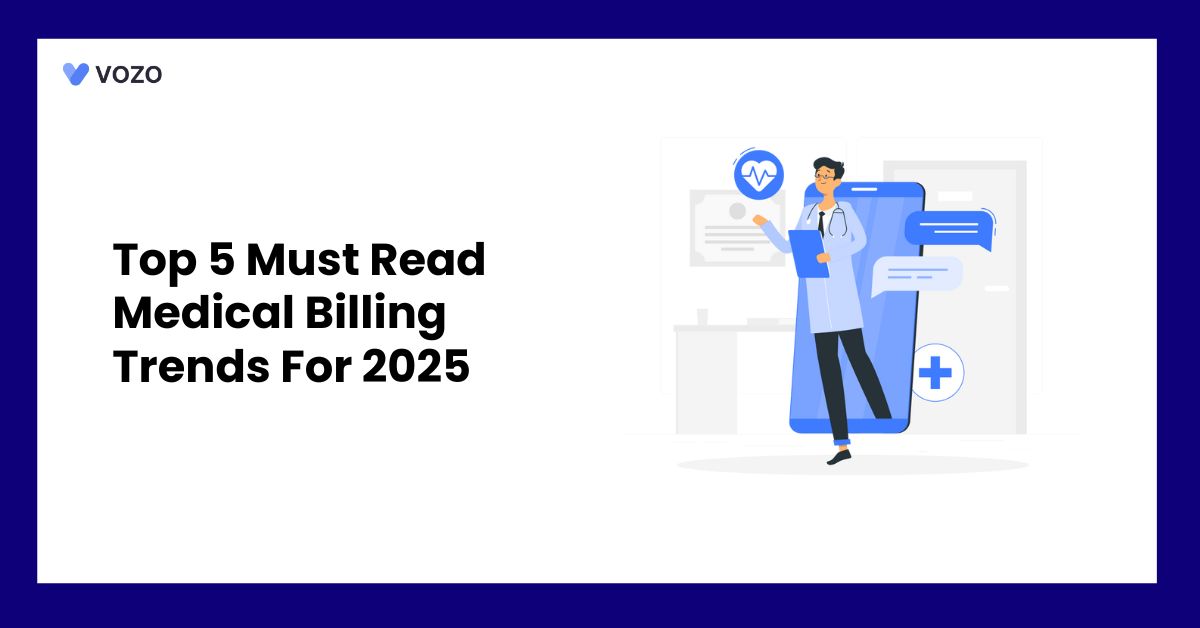Top 5 Must Read Medical Billing Trends For 2025
The medical billing market is changing drastically, due to regulatory updates, technological innovation, and shifting patient care techniques. Maintaining operational efficiency and financial health requires healthcare providers and RCM specialists to stay up with these changes.
In this blog, you’ll know the top 5 trends to know about healthcare medical billing for 2025.
Top 5 Medical Billing Trends in 2025
1. Expanding Telehealth Services
Telehealth has seen rapid growth in recent years during COVID-19. Expansion of telehealth services includes AI-powered technologies, value-based care. New CPT codes for telemedicine, encompassing codes for virtual consultations, and government efforts result in higher reimbursement rates.
Medicare and various private insurers have shifted towards equal payment for specific telehealth services, indicating that virtual consultations are compensated at the same rate as face-to-face appointments. This change removes a major financial obstacle to the adoption of digital health.
AI technology is used to automate tasks, enhancing the patient experience. Algorithms based on machine learning enhance scheduling times, forecast cancellations, and adjust calendars in real-time, leading to increased usage rates for clinics. Concentrating on value-driven care, which enhances patient results and cost efficiency.
Related: The Definitive Guide to Medical Billing
2. Adoption of New Technologies
Technology is everywhere, and healthcare is now utilizing it to give better care to its patients, enhance practice revenue, and communicate with patients securely.
- Robotic Process Automation automates human tasks like data entry, eligibility checks, claims cleaning, and payment posting. Bots can handle claims faster than manual teams due to their 24/7 operation. Standardized workflows prevent transcribing and coding errors. Automated code assignment can boost claim generation by up to 50%.
- Natural Language Processing Models Extract clinical information from EHR notes and assign ICD-10/CPT codes. ML algorithms use previous claims to forecast and prevent claim denials.
- Blockchain generates records, unchangeable transactions of payments and billing events. Records that cannot be altered less fraud and disagreements. Payors, providers, and patients can exchange data in real time thanks to shared ledgers.
- EHR integration and modular scalability are made possible by cloud-hosted RCM systems that are based on HL7 FHIR standards. Scheduling, healthcare documentation, and patient payment portals are all connected to billing through interoperable APIs.
3. Cybersecurity and Security Compliance
The goal of medical billing is to lower healthcare expenses by enhancing transparency and safeguarding patient information. It needs to adhere to new data protection regulations that are now in force and follow current standards, such as HIPAA, GDPR.
These regulations necessitate robust security protocols in billing systems, often including stringent guidelines for the management, storage, and transmission of patient information. To prevent cyberattacks, protective strategies such as multi-factor authentication and strong data encryption are implemented. Implement ongoing surveillance, zero-trust network policies, and AI-driven security systems.
4. Data Analytics for Revenue Cycle
Data analytics provides insights into revenue cycle management to improve the financial performance of the medical practice. Data analytics identify the patterns for claim denials, and providers can take the necessary steps to reduce claim rejections.
By evaluating accounts receivable (AR) according to their estimated probability of payment, practices can concentrate their collection efforts on accounts that promise the greatest return. Predictive analysis helps to forecast revenue trends and key areas for improved cash flow.
Easily accessible visualizations allow users to identify negative trends promptly and allocate resources accordingly. Dashboards provide real-time data, which converts to key metrics that help to monitor the revenue cycle performance.
5. Patient-Centric Healthcare Billing
Patient-centric healthcare Billing has emerged as a major trend transforming the traditional billing system to prioritize the patient’s ease, comfort, and clarity. Enhancing the billing process to make it simpler for patients to comprehend, clear, and flexible is the primary aim of patient-focused billing. This approach aims to improve the overall patient experience, increase trust, and minimize confusion.
Patients are now responsible for a significant portion of healthcare spending; therefore, improving the billing experience is critical. Patient-centric billing not only increases satisfaction but also encourages timely payments, decreasing the financial burden on healthcare providers.
Related: A Provider’s Guide to Solving Medical Billing Issues with Integrated Payment Solution
Vozo EHR Integrated with Medical Billing
Medical billing is a complex healthcare operation that requires efficiency and precision. Delayed payments, claim denials, and manual errors can slow your revenue cycle and affect cash flow.
With Vozo’s Cloud EHR solution, you get an integrated medical billing system that simplifies your billing process and enhances real-time claim tracking to improve payment turnaround.
How Vozo EHR Transforms Medical Billing:
- Streamline billing workflows and reduce administrative workload.
- Instantly identifies and corrects coding errors before claim submission.
- Speeds up claim verification with automated payer communication.
- Ensures compliance with built-in coding checks and regulatory updates.
- Offers real-time analytics and reporting for better decision-making.
- Minimizes delays by automating claims processing and payments.
- Reduces billing disputes with accurate, transparent invoicing.
Vozo EHR’s seamless integration with medical billing empowers healthcare providers to reduce errors, prevent delays, and optimize revenue cycles, all while focusing on delivering better patient care.
About the author

With more than 4 years of experience in the dynamic healthcare technology landscape, Sid specializes in crafting compelling content on topics including EHR/EMR, patient portals, healthcare automation, remote patient monitoring, and health information exchange. His expertise lies in translating cutting-edge innovations and intricate topics into engaging narratives that resonate with diverse audiences.













